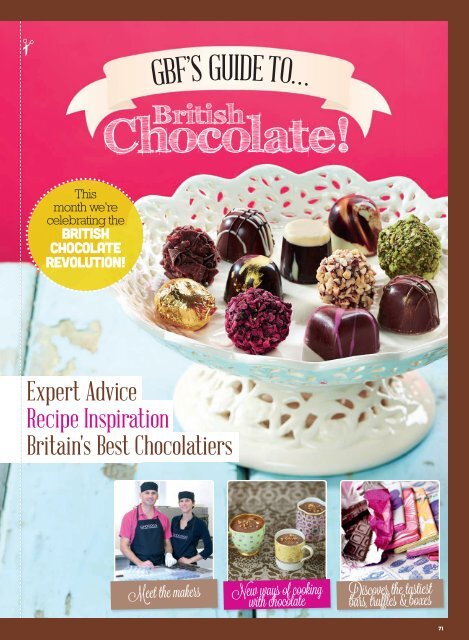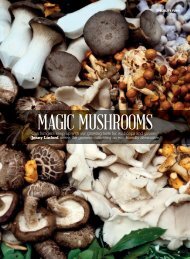Chocolate feature.pdf - Jenny Linford
Chocolate feature.pdf - Jenny Linford
Chocolate feature.pdf - Jenny Linford
You also want an ePaper? Increase the reach of your titles
YUMPU automatically turns print PDFs into web optimized ePapers that Google loves.
✁<br />
This<br />
month we're<br />
celebrating the<br />
British<br />
chocolate<br />
revolution!<br />
GBF’S GUIDETO…<br />
Expert Advice<br />
Recipe Inspiration<br />
Britain's Best Chocolatiers<br />
Meet the makers<br />
New ways of cooking<br />
with chocolate<br />
Discover the tastiest<br />
bars, truffles & boxes<br />
71
78<br />
These are exciting times for chocolate lovers in Britain, with talented, home-grown<br />
chocolatiers springing up around the country. <strong>Jenny</strong> <strong>Linford</strong> finds out more<br />
here’s been an<br />
unquantifiable<br />
revolution in<br />
the British<br />
chocolate<br />
scene in the last ten to 15 years,” says<br />
chocolate expert Sara Jayne Stanes of<br />
the influential Academy of <strong>Chocolate</strong>,<br />
founded to promote the knowledge and<br />
appreciation of fine chocolate. “There’s<br />
a huge thirst for knowledge now, not<br />
just among chocolate people but among<br />
consumers. I liken it to the wine scene.<br />
20 years ago people just used to say<br />
white, red or rosé, but now they’re<br />
interested in the grape varieties and<br />
where it came from. A similar thing is<br />
happening in chocolate, with people<br />
interested in knowing the country of<br />
origin for the cocoa and which variety<br />
it is.”<br />
Founded in 1983, Chantal Coady’s<br />
chocolate company Rococo was an early<br />
pioneer of quality chocolate in Britain.<br />
“In terms of chocolate it was the dark<br />
ages then,” laughs Chantal. ‘’Dark<br />
chocolate meant ‘bitter’ chocolate which<br />
meant Bournville.” Rococo introduced<br />
flavoured bars – in intriguing flavours<br />
such as chilli or basil and Persian lime –<br />
long before their current fashionability.<br />
“Our Rococo style is classic yet<br />
innovative,” she says, “so, for example,<br />
orange with geranium is our little twist<br />
on classic orange. I think as a nation we<br />
like to experiment with things and tweak<br />
them; we’re a bit irreverent as well. We<br />
like to have our taste buds challenged.”<br />
With Chantal having studied textile<br />
design, inviting visual presentation as<br />
well as quality chocolate has always part<br />
of Rococo’s appeal. “Coming into my first<br />
shop on the Kings Road was a theatrical<br />
experience; you’d be embraced by the<br />
physical environment as well as<br />
welcomed by charming staff. We had<br />
sugar chandeliers and painted ceilings. It<br />
was quite wacky!” In addition to three<br />
elegant shops in London, last year saw<br />
Rococo opening in Chester at the<br />
Grosvenor Hotel. “It’s going really well,”<br />
she says happily, “the customers see that<br />
we’re selling fresh chocolates and<br />
they’re happy to spend a few pounds<br />
buying a real treat for themselves.”<br />
Creative Confections<br />
Having opened his first, eponymous<br />
chocolate shop in Islington, London<br />
seven years ago, award-winning<br />
chocolatier Paul A Young now has three<br />
shops in London and is noted for his<br />
artisan approach to making chocolate.<br />
“We do everything by hand,” declares<br />
Paul emphatically, “that’s our ethos.<br />
When we say hand-made we mean it. It<br />
means we can employ people, not<br />
machines.”<br />
Working with chocolate is a technical<br />
business and one of the key skills is an<br />
intricate process called tempering.<br />
“Tempering introduces hardening<br />
crystals into the chocolate, so it makes<br />
chocolate shiny, crisp, so it shrinks away<br />
from the mould, gives the lovely smooth<br />
texture and feel. We do all our<br />
tempering by hand on marble and<br />
granite slabs. We don’t have tempering<br />
machines.”<br />
For Paul, this hands-on, human<br />
relationship with chocolate is central to<br />
what he does. “When you use a<br />
machine, you know what it does. I’m<br />
relying on myself, on my team; it’s not<br />
guaranteed to work all the time; there<br />
are some days when you can’t get the<br />
tempering right. But if people come into<br />
my shop and see beautiful chocolates,<br />
that means we’re getting it right.”<br />
Ever since Paul, challenged by a<br />
friend, created his iconic Marmite truffle<br />
(still one of his bestsellers seven years<br />
later), he’s been known for his<br />
inventiveness and creativity. In addition<br />
to core favourites, he is constantly<br />
bringing out new, seasonally-inspired<br />
flavoured truffles, from port and Stilton<br />
to goat’s cheese and lemon. “That’s what<br />
brings my customers back; we can’t stop<br />
innovating. I can’t describe the process<br />
of creating flavours,” he muses. “The<br />
process is quite organic and fluid,<br />
though sometimes you spend weeks and<br />
weeks developing it, playing around. For<br />
me, it’s just about being brave.<br />
Sometimes the simplest things are best.<br />
When people are still buying flavours<br />
like my salted caramel or my raspberry<br />
which they have done for years, that’s<br />
when you realise you’re doing it right.”<br />
Golden Ticket<br />
In 2002, inspired by a love of fine<br />
chocolate, Claire Burnet and her<br />
husband Andy took the plunge and left<br />
their “well-paid, corporate jobs” to set<br />
up Chococo, their Dorset-based<br />
chocolate company. “It was one of those<br />
mad ideas that got into my head and<br />
which I couldn’t get out,” laughs Claire.<br />
“It’s been hard work but immensely<br />
rewarding. We are very much anchored<br />
in Dorset, we were the first chocolate<br />
makers to really focus on using fresh<br />
and local ingredients, so our cream still<br />
comes from the dairy farmer we bought<br />
it from ten years ago. Our fresh<br />
chocolates really are fresh; they have a<br />
shelf-life of two weeks. People do make<br />
chocolates that will sit on your coffee<br />
table for months because they use<br />
glucose syrup and lots of alcohol; we<br />
don’t do that. We employ local young<br />
people and, being by the sea, we’re one<br />
of the busiest employers in the offseason,<br />
as winter is our busiest time.”<br />
For Claire, spreading the word about<br />
good chocolate is part of her work.<br />
“Unfortunately in this country we’ve<br />
been eating chocolate that’s had a lot of<br />
sugar added and also, sometimes, had<br />
vegetable fat substituted for cocoa<br />
butter. It’s getting folks to differentiate<br />
that chocolate confectionery product<br />
from premium, proper chocolate and<br />
getting people to appreciate that dark<br />
chocolate is full of flavour, you get citrus<br />
fruit notes, red fruit notes.”<br />
Accessibility is very much part of<br />
Chococo’s approach. “We try to have fun<br />
with our chocolate. We take the quality<br />
of the chocolate very seriously but we<br />
present it in a way which is ‘exclusively<br />
for everyone’, to quote an old M&S<br />
catchphrase. People love to give<br />
chocolate to their children, so give them<br />
great quality milk chocolate that’s high<br />
in cocoa solids, low in sugar, without<br />
vegetable fat and which tastes of<br />
chocolate not of sugar. Ideally, give them<br />
✁
✁<br />
dark chocolate; educate their palates.”<br />
Chocolatier Karl Berrie of Cocoa Red<br />
is on a personal mission to bring fine<br />
chocolates to the Isle of Man, where he<br />
lives and works. “It’s a beautiful place.<br />
Everyone knows each other and it’s so<br />
friendly. It’s starting to develop a bit of<br />
a good food scene. The price point for<br />
quality chocolate is an issue. When we<br />
win awards, our customers think we<br />
must be doing something right!” Using<br />
local suppliers is also very much part<br />
of their ethos. “We use Manx cream<br />
from Isle of Man Creameries and Cooil’s<br />
Dairy. We have a really good<br />
relationship with them. If I run out of<br />
cream at 1am in the morning, I can go<br />
to the dairy and help myself. As an<br />
island-based community, there’s a lot<br />
of trust.”<br />
Cloud Cocoaland<br />
Many of Britain’s leading chocolatiers,<br />
such as William Curley, trained first as<br />
pastry chefs and learnt about working<br />
with chocolate in this way. Based in<br />
Tunbridge Wells, Kent, creative<br />
chocolatier Damian Allsop had a<br />
glittering career as a pastry chef,<br />
working in Michelin-starred restaurants<br />
including The Aubergine, with Gordon<br />
Ramsay, and Locanda Locatelli, with<br />
Giorgio Locatelli. Damian is known as a<br />
pioneer of water-based ganache, as<br />
opposed to the traditional cream-based<br />
ganache. It was his discovery of how to<br />
make a successful water ganache which<br />
prompted his move to become a<br />
chocolatier. “When I worked out the<br />
water ganache, I knew I had something<br />
different. When you taste one of my<br />
water ganache it’s a purer flavour, you<br />
don’t miss the cream. People think by<br />
taking away the cream you’re taking<br />
away the luxury, but there’s richness in<br />
the chocolate. People say my chocolates<br />
are ‘refreshing’, which is an unusual<br />
adjective to use about dark chocolate.”<br />
This inventiveness is very much part<br />
of Damian’s approach to his work. “I’ve<br />
always wanted to do something<br />
different, I hate copying other people or<br />
doing the same thing all the time.<br />
<strong>Chocolate</strong> as a medium is so complex,<br />
there are lots of different ways to use it.<br />
It’s exciting at the moment because<br />
there’s lots of new chocolate being<br />
made. Different people are getting<br />
access to cocoa beans. There are small,<br />
artisan producers who are producing<br />
amazing chocolate for chocolatiers to<br />
work with and that’s inspiring. I want to<br />
respect the flavours that chocolate has.”<br />
Among Damian’s recent creations are<br />
a series of Eat London bars – inspired<br />
by London’s multi-cultural communities<br />
with flavours such as chocolate with soy<br />
sauce peanuts and ginger for his<br />
Chinatown bar or mango and basmati<br />
rice crisps for Brick Lane “I wanted to<br />
express Britishness - it’s very accessible<br />
and fun. All the flavours are honest. I<br />
make the elements – like the rice crisps<br />
– myself.”<br />
With the Academy of <strong>Chocolate</strong><br />
expecting more entries than ever for its<br />
prestigious Awards this year, Sara Jayne<br />
Stanes feels that we’re only at the<br />
beginning of Britain’s chocolate<br />
revolution. “I think things will continue<br />
to grow; we’re not there yet. There will<br />
be more talented chocolatiers, more<br />
people making bean to bar chocolate –<br />
watch this space!” Damian Allsop is also<br />
looking to the future. “We need to<br />
promote British chocolatiers. We’re now<br />
seeing British chocolatiers among the<br />
top in the world, whereas 10 years ago,<br />
none of us were there. It’s exciting.”<br />
British<br />
<strong>Chocolate</strong>s<br />
2o years ago people just used to say white, red or rosé, but now they’re interested in the grape<br />
varieties and where it came from. A similar thing is happening in chocolate!<br />
79





